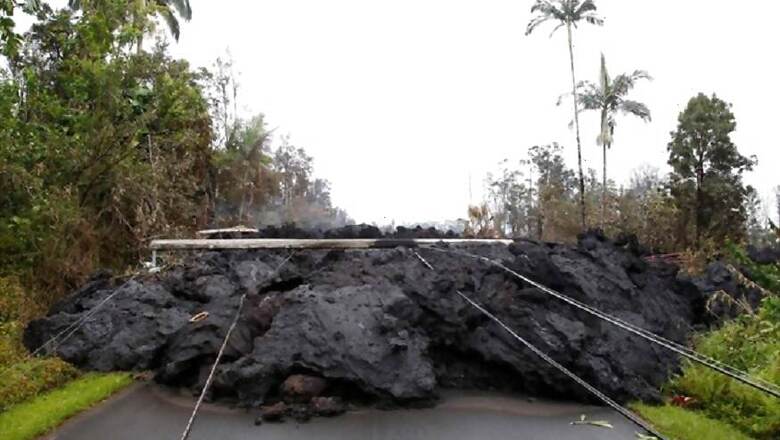
views
Hawaii: The latest bursts of molten rock, ash and toxic gas from Kilauea Volcano on the Big Island of Hawaii are part of an ever changing and still largely mysterious cycle of eruptions that have been at work for hundreds of thousands of years.
Kilauea, one of the world's most active volcanoes and perhaps the most intensely studied, began extruding red-hot lava into populated areas through newly opened fissures in the ground last week, destroying dozens of homes and other buildings, and prompting mass evacuations.
The lava-spewing fissures were accompanied by a flurry of earthquakes. An ash plume belched from Kilauea's long-active Pu'u 'O'o side vent last week, and on Wednesday volcanic rock exploded from the main summit crater, which could portend a wave of similar eruptions to come.
All of this activity, according to geologists and vulcanologists, is driven by the underground ebb and flow of huge rivers of molten rock called magma -- the term for lava before it reaches the surface -- and is part of an eruption cycle that has continued nearly nonstop on the island for 35 years.
But experts say the behavior exhibited by Kilauea differs from one eruptive episode to the next, and they hope the latest sequence of events will help them better understand why.
"When all of this is over, and we digest the reams and mountains of data that we are collecting, we will know a lot more about Kilauea as a volcanic system," Christina Neal, the volcanologist in charge at the Hawaiian Volcano Observatory of the U.S. Geological Survey, told a news conference on Wednesday.
Scientists acknowledge having no idea how much longer the latest upheaval will last, though there were clear signs something was brewing before it started.
EAST RIFT ZONE
Magma had steadily bubbled up for weeks inside the main crater at Kilauea's summit, and at the separate Pu'u 'O'o crater miles (kilometers) away on the volcano's eastern flank called the east rift zone.
Instead of lava breaking through the outside wall of the Pu'u 'O'o cone, as it did twice before in recent years, the crater floor abruptly collapsed on April 30. The pool of magma drained back into an underground reservoir and pushed its way into deep channels carrying the molten rock farther downslope.
This sequence of events created space for additional magma from Kilauea's summit to recede back underground and likewise flow downhill into the sub-surface rift line. When that happened, a lava lake that had spilled over the crater rim just weeks before suddenly dropped by hundreds of feet (meters).
By last Thursday, the underground flows found their way to the surface in the community of Leilani Estates, opening large cracks in the ground to emit steam, toxic sulfur dioxide and other volcanic gases, and finally fountains of lava, some hundreds of feet (meters) high.
Fourteen such fissures had been counted as of Wednesday, and scientists said more were likely in the days and weeks ahead.
"There's still a fair bit of magma right underground that's available to erupt," Neal said.
The earthquakes, including a powerful magnitude 6.9 tremor on May 4 -- the strongest in Hawaii since 1975 -- were produced by the enormous pressure being exerted miles (km) beneath the surface on fault lines around the volcano from the massive intrusion of magma underground.
NEW CHAPTER
On Wednesday, scientists observed what they believe may signal a new chapter in the latest series of disturbances -- the violent explosion from the summit crater of rocky material that apparently fell into the remaining lava lake.
Such blasts could grow more frequent if the receding magma in the summit chamber drops below groundwater levels, allowing steam to rush into the void and become trapped by more rock falls, causing explosive pressure buildups, scientists said.
The filling and draining of Kilauea's magma reservoirs has recurred countless times over the history of the volcano, which has been active for hundreds of thousands of years and helped build the largest island in the Hawaii archipelago.
But scientists remain uncertain what caused Kilauea's latest buildup of molten rock and why the magma traveled so far underground to create new ground vents "when it had two release valves" already at the summit crater and at Pu'u 'O'o, said Michael Garcia, a volcano expert at the University of Hawaii.
"Why it would push magma 10 miles (16 km) down from where it was erupting is a mystery," he said.
Garcia said Kilauea's current eruption cycle, which has persisted with no more than a month's pause for 35 years, is already its longest in the last five centuries. But that record pales in comparison to a volcano in Costa Rica that has been continuously erupting since 1968.
How and when Kilauea will fall silent again has yet to be determined.




















Comments
0 comment